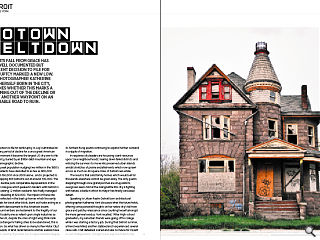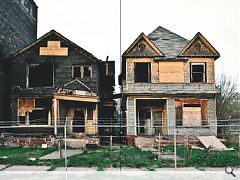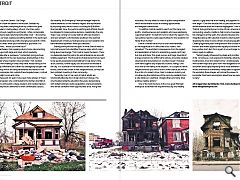Detroit
23 Oct 2013
Detroit's fall from grace has been well documented but its recent decision to file for bankruptcy marked a new low. Here photographer Katherine York, herself born in the city, examines whether this marks a bottoming out of the decline or is just another waypoint on an inexorable road to ruin.
Detroit’s decision to file for bankruptcy in July culminated an extraordinary period of decline for a once great American city, in that moment it became the largest US city ever to file for bankruptcy, buried by an $18bn debt mountain and eye watering demographic decline.From a peak population nudging two million in the 1950’s Detroit’s residents have dwindled to as few as 800,000 today, down 150,000 since 2000 alone… and is projected to carry on dropping till it bottoms out at around 700,000. This precipitous decline puts comparable depopulations in the shade, even Glasgow which peaked in tandem with Detroit in the fifties boasting 1.2 million residents has finally managed to stem the bleeding at 620,000. The impact of these raw statistics is reflected in the beat up homes which line eerily empty streets for block after block, burnt out husks acting as a scorched earth denouement to the American dream.
These burnt embers are testament to the fragility of our society, particularly one as reliant upon single industries as Detroit. In the UK, despite the cries of right wing think-tank the Policy Exchange for failing cities to be abandoned, this is not an option. So what has driven so many to flee Motor City? A copious supply of land, racial tensions and tax evasion have combined to see the city hollow out in unprecedented degree, its furthest flung exurbs continuing to expand further outward in a ripple of migration.
In response city leaders are focussing scant resources upon ‘core neighbourhoods’, tearing down failed districts and enticing the survivors to move into preserved urban islands amidst stretches of prairie and allotments which now sprawl across as much as 40 square miles of Detroit real estate.
The result is that solid family homes which would sell for thousands elsewhere cannot be given away. The only guests stepping through once grand porches are drug addicts, overgrown lawns hint at the losing battle this city is fighting with nature, a batle in which its mayor has finally conceded defeat.
Speaking to Urban Realm Detroit born architectural photographer Katherine York discusses what the future holds, offering some personal thoughts on her native city’s fall from grace and patchy renaissance since counting herself amongst the more general exodus. York recalled: “After High-school graduation, my suburban friends were going off to college while I was starting a factory job. During that Detroit summer, a friend was killed, another stabbed and I experienced several close calls. I felt defeated, scared and saw no future for myself, so out of desperation, I bought a one-way bus ticket to the furthest city from Detroit - San Diego.
“I don’t have the desire to move back. Besides my family living there, everything from my childhood is gone - the theaters, bowling alleys, schools, churches, parks, neighborhoods, neighbors and friends. I often contemplate how someone feels returning home after a war - discovering who has survived, seeking something familiar in the destroyed unrecognizable landscape with emerging new growth. I think about this often, when your homeland as you know it no longer exists... would you move back?”
Nevertheless York regularly returns home, documenting the changes, both large and small, which inevitably accumulate after a spell away. “I visited last spring and was disorientated from the new businesses and buildings in the city center where investors have set stake,” York recalled. “People were walking in areas they never would have just five years ago. Billionaire Dan Gilbert has strategically bought over 25 buildings which are being refurbished and leased to new startup companies. But, outside these targeted areas, I noticed further blight, arson and crime.
“In these past 20 years I have seen many phases of ‘hope’; from new leaders who contributed to the further downfall of the city, to enthusiastic college students and creative hipsters who quietly return unfinished to their comfortable suburbs. But recently, the Emergency Financial Manager helped to create awareness of the shameful neglect and exploitation by exposing many serious issues, including the $18 Billion financial debt. Now, the world is watching and officials should be obligated to make positive decisions. Realistically, the only ‘hope’ I see coming is in a new Detroit, with new investors and new residents; unfortunately resulting in the eventual displacement of many surviving businesses and residents who have remained optimistic these past decades.”
Sharing some personal thoughts on what Detroit needs to turn itself around York identifies three key steps which could bring about real change. “First, Detroit needs the basics. There is a desperate need for police, fire and ambulance service with reliable equipment. The thousands of abandoned homes need to be quickly assessed and demolished to help lower crime, arson, sickness, further equity loss and boost the morale of the city. It is essential for the residents to feel secure in their homes, safe to take a walk in their neighborhoods, so they can feel confident investing in their community.
“Secondly, Over 47 per cent of Detroit adults are functionally illiterate, this is tragic and must change. The city should provide the education they were denied along with skilled training to build a population of proud residents who will be confident when opportunities arise. Along with education, the city needs to invest in public transportation which would enable access to existing opportunities and integrate communities.
“In addition, Detroit needs to search out the many non-profits, small businesses and residents who have relentlessly supported Detroit - its Detroit’s turn to return the support. The new policies need to create opportunities for the residents not hinder them further.”
Detroit’s travails have struck a chord internationally as the magnitude of its difficulties cross oceans. York remarked: “The exorbitant consequences from the neglect and exploitation of Detroit is astonishing, people can’t help but stop and stare. This great success and tragic downfall of a large American city within half a century, should be studied, observed and documented on countless levels.” However York warns against any voyeuristic tourism, noting: “One must look at the reality of the situation. In a couple of Detroit neighbourhoods you have a one in seven chance you will be the victim of a violent crime. I feel, to make an industry out of witnessing the misfortune of the surviving residents from a safe distance is unethical. I imagine there are many other positive creative options.”
One of the main fractures in the once great Michigan metropolis is between the impoverished city and wealthy suburbs, a gap which far from healing, only appears to grow ever larger: “Over the decades the city and suburbs have shown extreme racial and financial segregation” York states. “Detroit being primarily low income African American & the surrounding suburbs, middle to high income Caucasians. This has changed over the years, the suburbs have become more integrated along with suburban investors entering Detroit, displacing the lower income African American population. Creating legitimate public transportation that crosses these borders and makes opportunities equally accessible would be a positive start. But, this is a part of a much larger issue the nation needs to address.
“Detroit greatly influenced my ideals and priorities in life. Growing up, I was exposed to hardship, adversity, racial tension, arson and violent crime - amidst people with resilient hope and spirit. Now I feel obligated to honestly document landscapes exposing these social elements that would otherwise be overlooked, manipulated or ignored; with the aspiration these images will compel the viewer to reconsider their basic assumptions about how we evolve as a society.”
All images taken by Katherine York, www.studioyork.com; email info@studioyork.com
|
|
Read next: Atria Edinburgh
Read previous: Glasgow City Centre
Back to October 2013
Browse Features Archive
Search
News
For more news from the industry visit our News section.
Features & Reports
For more information from the industry visit our Features & Reports section.





